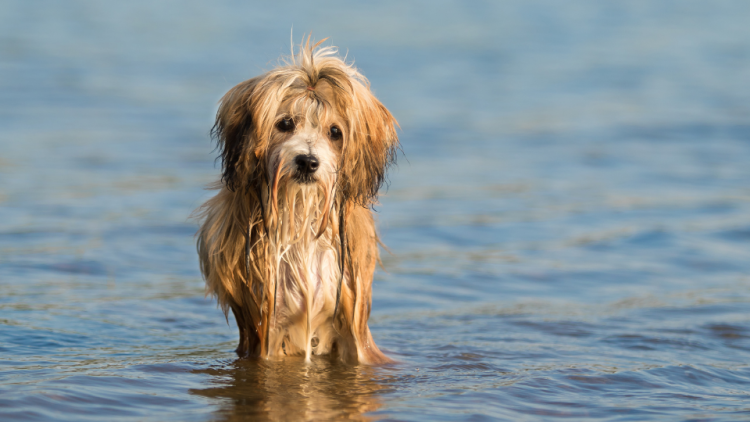Havanese, also known as the Havana Silk Dog or the Spanish Silk Poodle, was the favorite lapdog of many aristocrats and has become a popular dog breed for many pet parents worldwide. Known as the only dog breed native to Cuba (hence the name), the Havanese likely had Bichon Frise and Maltese dogs as their ancestors before they developed into a unique dog breed. These cheerful little dogs are intelligent, outgoing companions who make wonderful pets in big cities due to their small size. They also make sharp watchdogs without the propencity to bark.
If you’re the lucky pet parent to one of these smart and silly extroverts, you may be wondering just how big do Havanese dogs get? Use our Havenese weight chart below to track your puppy’s predicted growth weight in development.
Here’s everything you need to know about Havanese weight, size, and growth rate:
- Havanese Weight Chart
- At what age is a Havanese fully grown?
- How big should a 6-month-old Havanese be?
- How much bigger will my Havanese get?
- What is the size of a full-grown Havanese?
- How do I make sure my Havanese is healthy?
- Key Takeaways
Pro Tip: New pet parents can get reimbursed for up to 90% of veterinary bills by enrolling in a pet insurance plan. Compare Havanese health insurance options today to set up a safety net and give yourself peace of mind knowing that your pup has access to gold-standard care for life.
Havanese Weight Chart
| Age | Weight |
|---|---|
| 1 month old | 1 - 3 lb |
| 2 months old | 2 - 3 lb |
| 3 months old | 3 - 4 lb |
| 4 months old | 4 - 6 lb |
| 5 months old | 5 - 7 lb |
| 6 months old | 6 - 8 lb |
| 7 months old | 6 - 10 lb |
| 8 months old | 7 - 12 lb |
| 9 months old | 7 - 13 lb |
| 10 months old | 7 - 13 lb |
| 11 months old | 7 - 13 lb |
| 12 months old | 7 - 13 lb |
Please keep in mind that the Havanese weight ranges are estimates, so don’t worry if your dog is slightly above or below! Your puppy’s health is the most important factor, and all puppies grow at their own rate. If your pup is developing significantly slower or faster than what you see in the Havanese growth chart, consult with your veterinarian to make sure they’re in good health.
At what age is a Havanese fully grown?
You can expect your Havanese puppy to reach their weight and height by six to eight months old. As a toy dog breed, the Havanese reach their adult size relatively quickly, compared to large breeds that require 18 to 24 months to finish filling out. Also, unlike many dogs, there is no noticeable difference between the size of a male and female Havanese. Both tend to be around the same weight and height.
How big should a 6-month-old Havanese be?
A 6-month-old Havanese puppy will be at their adult size or close to it. Male and female Havanese puppies may weigh between 6 to 8 pounds at six months old and will likely already be at their adult height, typically between 8.5 to 11.5 inches tall.
Pro Tip: Check out this new puppy checklist for tips on how to puppy-proof your home, set up a vaccination schedule, stock up on supplies, and more.

How much bigger will my Havanese get?
There are a few ways to estimate how big a Havanese dog may get:
- Age. If your Havanese puppy is less than six months old, then they likely still have growing left to do. If they are eight months or older, then they are probably finished growing.
- Paw Size. You can also take a look at your Havanese puppy’s paws. Are their paws still oversized next to their legs and body? This is a classic adolescent feature indicating that your pup still has growing left to do.
- Genetics. Lastly, try contacting your Havanese puppy’s breeder if you choose to purchase them through a breeder. Your breeder can provide you with a more exact estimate of their adult size based on their parents’ size and past litters. A puppy will rarely grow to be larger than its bigger parent, so this will also provide you with an idea of its maximum weight and height.
What is the size of a full-grown Havanese?
According to the American Kennel Club Official Havanese Breed Standards, an adult Havanese should weigh between 7 and 13 pounds and stand between 8.5 and 11.5 inches tall at the shoulders. There is no notable size difference between male and female adult Havanese dogs.
An adult Havanese should appear compact, slightly longer than tall, and have a springy gait, a famous breed hallmark. While their coats are stunning, it can be easy for Havanese dogs to put on excess weight without their pet parents noticing due to their lush double coats. To prevent this, it’s crucial that you regularly feel your Havanese’s body underneath their thick coat regularly to assess if they are continuing to put on weight.
How do I make sure my Havanese is healthy?
Our Havanese puppies are cherished members of the family who deserve the best. Unfortunately, the Havanese is a purebred dog which makes them more susceptible to various genetically inheritable diseases. As a pet parent, this can be heartbreaking to think about. However, many of these diseases can be prevented, minimized, or treated with routine top-notch veterinary care.

Remember that prevention is always better than treatment, making veterinary appointments at least once a year will help to preserve your precious pup’s health and overall happiness. During regular veterinary appointments, your veterinarian can screen your Havanese puppy for genetic diseases, provide personalized information and recommendations for healthy lifestyle choices for them, and monitor your puppy’s growth and development.
Havanese Veterinary Costs
The Havanese breed is especially prone to inflammatory skin disease, liver shunts, and eye problems such as cataracts, retinal atrophy, and eyelash disorders. Cataracts in dogs can occur for many reasons, but certain breeds, like the Havanese, are more prone to them due to their purebred lineage. In most cases, your veterinarian will recommend cataract surgery, as the condition can otherwise obscure your pup’s vision, cause discomfort, and may even lead to complete vision loss without treatment.
On average, cataract surgery costs between $2,700 and $4,000. Unfortunately, this is an expense that many pet parents are unable to pay out-of-pocket. This presents a financial burden that many owners are unprepared to face and often results in a challenging predicament at an already stressful time. However, pet insurance can provide you with a safety net by reimbursing you for a portion of out-of-pocket vet costs. Whenever your puppy is ill or injured, you can focus on getting your pet the top-notch care they deserve, at a price you can afford.
Insurance policies are customizable, so you can choose the right solution for your budget and coverage preferences. There are also wellness plans to complement the policy with extended coverage that includes the cost of preventive pet care, dental cleanings, vaccinations, and more.
Key Takeaways
- Our Havanese weight chart predicts the weight of your puppy until they stop growing around 6 to 8 months old.
- Official AKC standards define the ideal Havanese weight range as 7-13 pounds.
- Havanese dogs are susceptible to a number of hereditary diseases, particularly conditions of the eye.
- Pet insurance is a resource that pet parents can use as a financial buffer to offset the cost of keeping their Havanese healthy and happy.
